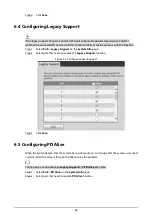
44
6 PoE
6.1 Configuring PoE Power
Background Information
Power over Ethernet (PoE) means the device is remotely powered up through the Ethernet port and
connected to the PD (Powered Device) with the twisted pair cable. The PoE function realizes the
centralized power supply and easy backup. The network terminal just uses one simple network cable
without external power source. It meets the IEEE 802.3af and IEEE 802.3at standard and adopts the
universal recognized power port. It is applicable for the IP camera, IP phone, wireless access point
(wireless AP), portable device recharger, POS, data acquisition and more.
Figure 5-1 PoE system
Table 5-1 Description of PoE system
Part
Description
PoE Power
Supplies power to the whole system.
PSE
Directly supplies power to the PD. Supports searching, detecting PD,
categorizing PD, realizing power consumption management and checking
the PD connection.
PI
The Ethernet port that has the PoE function. It includes FE and GE. The PoE
remote power supply has two modes:
●
Over signal wires: The PSE uses the pairs (1, 2, 3, 6) that transmit data in
3/5 twisted pair cable to supply DC power while transmitting data to PDs.
●
Over spare wires: The PSE uses the pairs (4, 5, 7, 8) that do not transmit
data in 3/5 twisted pair cable to supply DC power to PDs.
The power supply mode is different depending on the PD specifications. The
selected mode must support PSE and PD at the same time. If the PSE and the
PD power supply mode are not the same (the PSE does not support the spare
wire power supply, or the PD supports spare wire power supply only), use
converter to provide power to the PD.








































